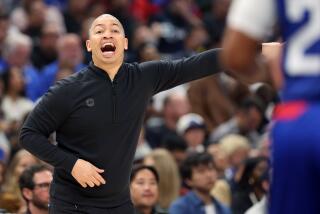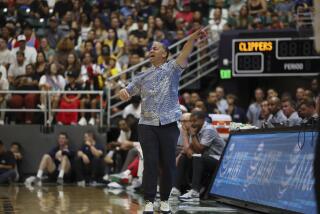SWITCHING TRACKS : Don Casey Brings New Train of Thought to Clippers
- Share via
DALLAS — Sitting on the couch in his 18th-floor suite of a hotel here just before 1:30 a.m., his feet atop a coffee table, Don Casey is getting philosophical. Having been awake for 16 straight hours has nothing to do with it, either, because he usually runs on only 4 or 5 hours’ sleep during basketball season.
What is different is that a major event in his life is drawing near. Later this day, Casey, 51 years old and previously only an assistant in the pros, will coach his first game in the National Basketball Assn.
“My feeling in life is that if you stop dreaming, you’re in trouble,” he says. “I don’t mean fantasizing, but I don’t want to stop reaching for the next plateau.”
That much has never been a problem for Don Casey, the new coach of the Clippers.
He was, by his own admission, an average-to-poor student in Collingswood, N.J., who hated to read and do homework. Now, he is rarely without three or four books on the road, always picking at each instead of digging into one full time, and his San Diego home has a library of about 750 hardbacks.
He needed 15 years to finish college, because of financial and job-opportunity interruptions. But now he feels as comfortable discussing World War II history, mythology or folk remedies as he is talking about the best way to beat a full-court trap.
He worked as everything from a restaurant busboy to a sweeper and ticket-taker at Garden State Race Track in New Jersey while growing up. Now, he sends money to and does some volunteer work with gun-control groups, Skid Row missions in Los Angeles and, through his position as a consultant with Reebok, Amnesty International.
He never moved more than 1 1/2 miles in the first 27 years of his life. But in the last 6 years alone, he has lived in Chicago, San Diego, Italy, a seminary in South Bend, Ind., while an assistant at Notre Dame and now, during the season to avoid the commute from San Diego, Hermosa Beach.
He got into coaching almost by accident, taking charge of the junior varsity team at Bishop Eustace Prep in Pennsauken, N.J., as a part-time job at the suggestion of a friend. Midway through the season, the varsity coach quit, and Casey, then 21, was promoted. At a school that didn’t even have its own gym when he started, Bishop Eustace won 2 state championships in 6 years.
He joined the staff at Temple University in 1966, working as an assistant under legendary Coach Joe Litwack. After 6 seasons, Litwack retired and Casey moved up again. He went 151-94, with a trip to the National Collegiate Athletic Assn. playoffs and 3 berths in the National Invitation Tournament in 9 years. He was named East Coast Conference coach of the year twice.
Then, there were years of bouncing around--2 stints with the Clippers as an assistant, a season as Paul Westhead’s assistant with the Chicago Bulls, 3 months as a head coach for Club Scalavini in Italy and 4 months as a volunteer assistant under Digger Phelps at Notre Dame.
Last week, when friend Gene Shue was fired as Clipper coach in the midst of an 11-game losing streak, Casey got another promotion, albeit as an interim coach until the end of the season.
“I think life is like a train going along, chug, chug, chug,” he says, feet still on the coffee table. “And the older you get, the faster the telephone poles go by. . . . At what point do you reach 60 m.p.h.? I don’t know. But I think the dilemma came in the 5 or 6 years when I kept coming back to adversity. Something inside of me always said that wasn’t the end of the journey.”
Which brings him to this station.
Even if he says being a head coach in the NBA never was a goal, it is, if nothing else, a financial peak, because it involved a $20,000 raise to $100,000 for the season. And then there is the new visibility. Chug, chug, chug, indeed.
“I think he’s one of the young Turks in the game who only needs time to get it done,” said Phelps, a longtime friend. “It won’t happen in the short time he has this season, and that’s what the Clippers need to realize.
“When he was a college coach at Temple, he was one of the most underrated coaches in the country. As far as all the concepts go, the guy just knows the game.”
Much of that knowledge can be traced to the days at Bishop Eustace, when Casey spent what extra time he had between odd jobs studying the Big Five of Philadelphia--Temple, Penn, Villanova, St. Joseph and La Salle. Some of the drills he picked up during those practices were implemented immediately at the high school and are now used with the Clippers.
From Jack McCloskey at Penn, now the general manager of the Detroit Pistons, he learned the zone defense that became the cornerstone of his own success at Temple.
In that glorious era of Philadelphia basketball, with Jack Ramsay and McCloskey and Litwack among others, he grew in his coaching, and soon the college types were visiting him to recruit Bishop Eustace players.
“I found that if I wanted to be with him, it would have to be at a game,” said his wife, Dwynne. “He couldn’t get enough of it. Casey (as she usually refers to him) would always be at the Palestra when some big-name coach or team would come to town. And we had to get there in time for warmups, not just for the start of the game, because he wanted to see what drills teams were doing.”
She might have expected as much, since basketball brought Dwynne and Casey together. Her younger brothers played at Bishop Eustace.
“All I ever heard from my brothers was about Mr. Casey or Coach Casey,” she recalled. “I thought that he was some old man. I never knew he was young. I always had a picture of an old man in my mind and groaned at this guy for keeping my brothers late at practice because I was the one who had to stop what I was doing at home to go and pick them up.”
But Casey was the youngest high school coach in the state. And he soon was one of its most successful.
He’s young again now, in pro experience, but the Clippers like his youthful exuberance. They like, in particular, the way he relates to a team dominated by first- and second-year players, with his great sense of humor and motivational abilities. In short, they hope Casey can strike a spark that has recently been missing.
But there is some urgency here. Casey has the final 3 months of the season to impress management. Who knows, maybe next fall he’ll be back living at the on-campus seminary at Notre Dame.
“There weren’t many people living there,” Casey says of the seminary. “But I will say this: I was not always the last one in at night.”
But seriously, folks . . .
Of his new responsibility, Casey says: “Before now, I still had some days of practice ahead of me, I had the write-ups to look at and I had the notoriety of the position. But we still haven’t played a game yet.
“When that part of it comes, I’ve decided to allow some of the veteran players to help me out with timeouts and stuff like that because I think guys like (Greg) Kite and Q (Quintin Dailey) and Gondo (Grant Gondrezick) and Norm (Nixon) are good with that.
“When you haven’t been in the scene full-speed in a while--with the 48-minute games, the 24-second clock--it’s a major adjustment, compared to being a head coach in college. But it doesn’t bother me at all that I’m looking to some of the players to help me out. People who don’t use other people to enhance their own awareness, to me, are stupid.
“I think (the interim role) puts me in a good position, because after we do well, I can negotiate much stronger, from a business standpoint. I have great confidence in these players.”
Stupid is something Casey has tried never to be with players.
“The best description of him would be as a players’ coach,” Westhead said. “That’s an enviable quality for an assistant, someone who can win the confidence of a player and act as a buffer. Don is terrific at that. But I don’t see any reason why the new position will change that.”
Clearly, though, this is a guy who can relate to people on many levels. Diversity is a tool he uses with success.
One moment, he’s yakking on the phone, networking with basketball coaches and friends around the country, the next he’s talking mythology. One days he’s developing an offensive formation, the next he’s . . .
Meeting with George Bush?
It happened in 1986, thanks to Casey’s connections with a couple of people on the staff of the then-Vice President. Along with Don Chaney, at the time the Clipper coach, they talked basketball and took a quick personalized tour of the White House.
Casey, who hopes to have the President meet the Clippers during an East Coast swing at the end of February, also got Christmas cards from Bush in 1986 and ’87. But he was skipped last year.
“I think I should have got one since he sent out 90,000,” Casey quips.
Indeed, Don Casey hangs with a tough crowd these days. He tweaks the President and prepares to coach his first game in the NBA at the same time. That train is really moving now. Chug, chug, chug.
More to Read
Go beyond the scoreboard
Get the latest on L.A.'s teams in the daily Sports Report newsletter.
You may occasionally receive promotional content from the Los Angeles Times.






